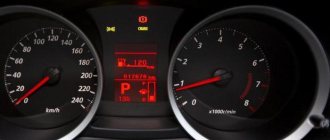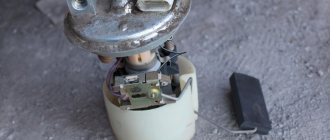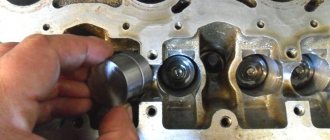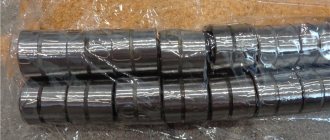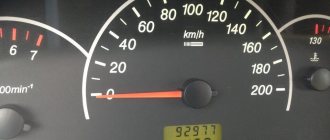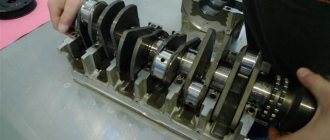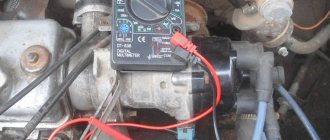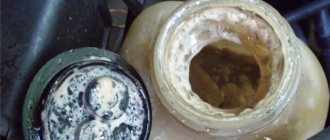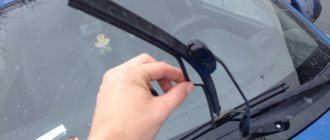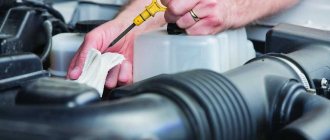The gasoline pump serves to supply fuel from the tank and maintain the pressure in the line necessary for the operation of the injectors. Interruptions in the supply of gasoline lead to a disruption in the composition of the air-fuel mixture, which leads to poor-quality combustion and misfires, the engine begins to stall, respond sluggishly to the gas pedal or stall. If the fuel pump (FP) does not pump, the engine will not start at all.
The fuel pump does not pump gasoline. Possible causes, ways to solve the problem
A car fuel pump is a device designed to provide an uninterrupted supply of fuel to the installation in which the fuel mixture is formed.
Even the slightest malfunction leads to interruptions in the operation of the engine, and in the event of more serious problems, you simply will not start it. In this article we will look at situations where the gas pump does not pump fuel at all, or pumps it, but not in the amount required by the power unit for normal operation. We will also try to understand the possible causes of this or that malfunction of the fuel supply device and discuss methods for eliminating them independently using the example of domestically produced cars carburetor VAZ-2109 and injection VAZ-2114.
What types of fuel pumps are there?
Cars with gasoline engines, depending on the make, model and modification, can be equipped with gasoline pumps of different designs. But they all fall into two main categories: mechanical and electrical. Most carburetor engines are equipped with mechanical fuel delivery devices. If we take the VAZ 2109 (carburetor), then from the factory it was equipped with a diaphragm pump manufactured by DAAZ. The main difference of this device is its simplicity of design, which is easy to understand even for a beginner. In the carburetor "nine" the fuel pump is located in the engine compartment of the car. It is easy to recognize by its characteristic hemispherical cap and fuel line hoses.
VAZ 2114 injection engines are equipped with electric fuel pumps. Their design is also based on a membrane, but unlike “mechanics”, the fuel supply devices in cars with automatic fuel injection are not under the hood, but directly in the tank.
Carburetor check sequence
On the car we tested, the engine air filter is located directly on the carburetor. Therefore, to gain access it must be disassembled.
- Remove the filter cover using a wrench. We take out the filter element (at the same time check its cleanliness) and unscrew the bolts securing the casing to the carburetor. Remove the body;
- Let's look inside the carburetor. Depending on the engine temperature, the throttle valve may be open or closed. In the second case, we open it by hand. Then we press the throttle mechanism drive and check whether a stream of gasoline appears from the pump;
- After making sure that there is gasoline in the carburetor, we get into the car, press the gas, and try to start the engine. If it doesn’t start, look further;
- Remove the top carburetor cover so that the fuel level in the carburetor chamber can be seen. The cover is secured with 5 screws. You should also disconnect the throttle cable bracket and turn off the idle air valve;
- Having released the float chamber, we assess the gasoline level. During normal operation of the fuel supply system, the level should be 23 mm below the walls. You can estimate the level using the tail of a caliper, having previously set it to a depth of 22-23 mm;
- We put the cover back on, fix it with a pair of screws, and start the engine again, having first depressed the gas pedal all the way;
- If the chamber is empty, the verification algorithm is slightly different. We put the lid on, leaving a small gap between the upper edge of the float chamber and the plane of the lid. We fix the gap with a flat steel ruler or a small screwdriver;
- We fill the chamber by manual pumping or by turning the crankshaft a few turns with the starter. After filling the chamber, we try to start again, having first secured the lid;
- The motor starts working - this is a sign of a malfunctioning needle valve. It should be replaced because it is almost impossible to restore it.
A tested and restored carburetor can be assembled, although it would be more correct to dismantle it (since you got to it anyway) and wash all internal parts with acetone.
Design of a carburetor fuel pump VAZ 2109
To understand why the VAZ 2109 fuel pump (carburetor) does not pump, let’s briefly look at its design. So, the “nine” fuel supply device consists of:
- housings;
- pusher with mechanical pumping lever;
- diaphragm assemblies;
- covers with valves and fittings for attaching hoses;
- mesh filter;
- manual pumping lever.
Operating principle of a mechanical fuel pump
The fuel pump is driven by the camshaft cam, which moves the pusher in a horizontal direction, causing it to perform reciprocating movements. The pusher, in turn, acts on the mechanical pumping lever, and it already raises and lowers the membrane rod.
Thus, a certain pressure is created inside the fuel pump, which is maintained by the valves of the device cover. One of them lets fuel in without letting it back in, and the second pushes it into the fuel line going to the carburetor.
As you can see, the design is very simple, therefore, to determine the reason that the fuel pump does not pump, it is enough to disassemble it and check the condition of the main elements.
Create an account
Register for an account. It's simple!
The fuel pump is an important component of the fuel system, responsible for supplying fuel from the tank to the carburetor or injector. On earlier car models, fully mechanical pumps were used to circulate the fuel mixture. Modern cars are increasingly equipped with electric counterparts. This type of pump is most relevant for cars with an injector. In addition to the standard function of supplying fuel, the electric fuel pump performs another very important task. The device creates optimal pressure in the fuel system to circulate the mixture through the injectors.
The principle of operation of the fuel pump and basic operating rules.
The operating principle of an electric pump is quite simple. Thanks to electric current, the pump moves the fuel mixture under a certain pressure. The operating principle of the mechanical analogue is somewhat different, but also not particularly difficult. The stop pushes the pump lever, which actuates the rod. This creates a regular back-and-forth movement of the membrane, due to which the fuel mixture enters the carburetor. As a rule, gasoline pumps are unpretentious to operate and do not require much attention. But at the same time, like any car device, the gas pump has certain operating rules. To maintain the good condition of the fuel system element, the fundamental factor is the use of high-quality fuel. The use of fuel with various impurities contributes to premature wear of the element. Thus, it becomes clear that the correct operation of the pump largely depends on the condition of the fuel filter. Regular replacement of a clogged filter will avoid considerable costs for repair and maintenance of the fuel system pump. The electric analogue has its own characteristics, based on which you should not allow maximum gasoline consumption. The fact is that the electric pump is cooled by the passing fuel flow. If the gasoline level drops below the minimum allowable level, the pump stops cooling and wear on the working component increases. If these rules are not followed, the pump may gradually malfunction. Over time, the car owner may face unpleasant consequences. Insufficient supply of the fuel mixture leads to a decrease in engine productivity. If the pump is significantly clogged, the car will simply refuse to start.
Signs of a malfunctioning gasoline compressor.
The first indicator of pump dysfunction is improper operation of the car engine. If the car is unstable in motion and begins to randomly pull out or brake, the fuel compressor is most likely faulty. Also, improper operation of the pump may be indicated by uncharacteristic sounds during vehicle operation and deterioration in vehicle acceleration. When functioning correctly, a gasoline compressor operates almost silently. Otherwise, it becomes necessary to diagnose the device. If during operation of a mechanical analogue leaks of working fluid are detected, it also becomes necessary to check the fuel system component.
Pump filter and manual pumping lever
The first thing you will see when you disassemble the fuel supply device is the strainer. It is made of thin perforated plastic. The reason why the fuel pump does not pump can also be if it is deformed or severely contaminated.
In the first case, the filter must be replaced, in the second, it must be washed with carburetor cleaning fluid.
The manual pumping lever has nothing to do with the fact that the fuel pump does not pump fuel when the camshaft rotates. The only thing that can break in it is the spring that tilts it back to its original position.
The fuel pump does not pump: injector
As already mentioned, pumps in carburetor and injection engines have different designs. In cars with forced fuel injection, all processes associated with its supply to the combustion chambers are controlled by an electronic control unit, so breakdowns of various types of electronic devices can occur here.
The main reasons why the fuel pump of an injection engine does not pump include:
- malfunction of the device's electric drive;
- pump filter clogged;
- relay failure;
- fuse blown.
The electric fuel pump does not work, possible causes of failure
In an engine with fuel injection, the fuel pump operates from the vehicle's on-board electrical network, so its failure is not always associated with a failure of the pumping mechanism itself. The cause of the malfunction may also be: a broken fuse, relay or oxidation, burnt contacts on the wires supplying the electric motor.
Another common cause of failure of the fuel pump of VAZ injectors can be a strainer installed at its inlet. Despite the fact that it is intended for primary and coarse fuel purification, its fabric has a rather dense structure. And since the pump is located in the tank, it practically touches its bottom and the sediment that accumulates there, which pollutes it.
Well, the worst thing is a breakdown of the engine responsible for circulating gasoline inside the pump, or failure of its structural elements.
How to understand that the cause of engine interruptions is the fuel pump
Diagnosing problems with the fuel pump in a car with an injection engine is much easier than in a car with a carburetor engine. The fact is that when you turn on the ignition, you can clearly hear the sound of the electric motor of the fuel module. It lasts for several seconds. This sound indicates that the fuel pump is turning and pumping fuel.
If this happens when you turn the key, then there is nothing wrong with the device itself, and the cause needs to be looked for elsewhere. Well, if when you turn on the ignition you do not hear the characteristic sound of the pump, you can be sure that the problem is in it, or in the elements of its energy supply.
Methods for checking the fuel pump
See also
Finding out whether a mechanical fuel pump is working or not is very simple; to do this, simply disconnect the end of the hose connecting the pump to the carburetor, and, lowering it into an empty container, press the manual primer lever and place it on the pump several times. In this case, gasoline should come out of the pipe in a pulsating stream. This will let you know if the internal components of the pump are working properly.
To understand why the fuel pump on an injection engine does not work, you must first “ring” its electrical circuit. It is better to start checking from the end point, that is, from the pump itself. A control lamp is connected to its terminals and if it lights up when you turn the key in the ignition, then everything is in order with the electrics, the fault must be looked for in the pump itself, if not, then in the fuse, relay or wiring.
To check the fuel pump itself, you need to find out what pressure it creates in the fuel rail:
- At a minimum, its value should be from 0.23 to 0.25 kPa.
- When starting the engine - 0.3 kPa.
- When you press the accelerator - 0.28-0.3 kPa.
- If the return pipe that returns excess gasoline to the tank is pinched, the pressure should rise to 0.4 kPa.
If in any of the modes the pressure does not correspond to the norm, it means that the fuel pump is not working properly - its elements are very worn out and require repair or replacement.
Start with the relay and fuse
Considering that the fuel supply module is located in the car tank, and it is not so easy to get to it, it is better to start diagnostics with the relay and fuse:
- Unscrew the screws securing the cover of the mounting block located to the left of the steering column.
- Underneath it, find fuse F3 (15 A) and relay R2. These are the elements that we need to check.
- As for the fuse, it needs to be “ringed” with a tester. If unusable, replace it.
Electric drive and filter
The fuel pump in the injection VAZ 2114 is an element of the fuel module, which is located in the car’s tank. It also includes:
- coarse filter;
- fuel level sensor;
- pipes for connection to the fuel line.
To get to the module, you need to remove the lower part of the rear seat, disconnect the wiring harness and unscrew the 8 screws securing its cover. Remove the entire device assembly. First of all, inspect the coarse filter. If it is clogged, replace it.
To test the electric motor, you will need to connect it directly to the battery terminals. If it is operating normally, “ring” the wiring and check the contact of the ground wire on the module cover. If the electric motor shows no signs of life, the question “why the fuel pump doesn’t pump” has finally found its solution.
It is not advisable to try to repair it yourself. Just buy a new motor and install it in place of the old one. And yet, you shouldn’t spend money on buying the entire module, which now costs about 3 thousand rubles. Buy the electric motor and a new filter separately. All this will cost you three times less.
Trouble-shooting
To repair a mechanical fuel pump, you will need to purchase a repair kit, which includes a diaphragm and valves - you can change these parts yourself. It will also not be difficult to replace the pusher with a spring. If the breakdown is more serious, then there is no point in resuscitation; it will be cheaper and easier to install a new fuel pump.
The electric fuel pump has a non-separable body, and it is not worth trying to repair it without certain skills; it is better to entrust such work to specialists. The only thing you can do yourself is to replace the mesh of the internal coarse filter. But even here you need to know that there are different types of meshes, so you will have to remove the filter from the tank to get a sample.
Why doesn't the fuel pump deliver gasoline?
One of the most important elements of the fuel injection system of a gasoline engine is the electric fuel pump, which is located in the fuel tank of the car. The fuel pump pumps fuel into the system from the gas tank, creating a certain pressure.
Auto repair experts identify the following common fuel system problems that are related to the fuel pump:
- The fuel pump pumps poorly and does not create the required pressure;
- the fuel pump does not pump when the ignition is turned on;
Considering that the fuel pump is an electromechanical device, the most common fuel pump malfunctions are related to both the mechanical and electrical parts. Next, we will look at what signs indicate a breakdown of the fuel pump and why the fuel pump stops pumping partially or completely.
Signs of fuel pump malfunctions
The main symptoms of fuel pump failure, as well as malfunctions in its operation, are:
- the car starts with difficulty, the engine runs unstable, there are dips, jerking when pressing the gas pedal, etc.;
- the pump does not pump after turning on the ignition, does not turn the starter and does not pump the fuel pump, the engine does not start;
There have also been cases when the fuel pump stops pumping while driving. In such a situation, the engine begins to malfunction and stalls immediately after the remaining gasoline in the fuel line is used up. The problem can occur either regularly or periodically.
The fuel pump does not pump: causes and diagnostics
Let's start with the fact that if the gas tank is full, the battery is charged, the spark plugs are dry and there is a spark, the starter turns the engine normally, but the engine does not seize, then you should pay attention to the gas pump. A common problem is that there is no power to the fuel pump after the ignition is turned on. In a similar way, the malfunction manifests itself in motion, when the power to the fuel pump is lost and the engine suddenly stalls.
An equally important point is how much the fuel pump pumps. In other words, the pump may hum and buzz (power is being supplied), but not create the required pressure in the fuel line. The pressure in the fuel system with a working fuel pump must be more than 3 bar (which depends on the specific car model). The indicated pressure is accumulated in the fuel rail and has an indicator of 300 kPa and above.
To check, you need to measure the pressure in the fuel rail with a pressure gauge, taking into account the indicators that are the norm for a specific car model. Using the example of injection VAZs, the pressure when the ignition is turned on is 3 atmospheres, at idle the figure is 2.5 atmospheres, when you press the gas 2.5-3 atmospheres. This method will help you accurately determine:
- malfunction of the fuel pressure regulator in the rail;
- breakdown of the fuel pump or a noticeable decrease in its performance due to wear;
- severe contamination of filters (fuel filter and/or fuel pump mesh);
In the second case, when you press the gas, the pressure does not increase; in the latter case, the pressure gauge needle rises, but very slowly or jerkily.
A decrease in pressure below the norm will lead to the fact that the engine may not start or start with difficulty, stall, jerk, operate unstably and with failures. If this happens due to the fault of the pump and not the fuel filter, then there is a high probability that the coarse filter screen of the fuel pump is clogged. In this case, there is no need to change the fuel pump itself, since it will be enough to replace or even clean the mesh.
If you suspect that there is no voltage to the fuel pump, there is a quick way to check. It is enough to turn the ignition key and listen, as when you turn the key you should hear a slight hum from the fuel pump. If such a buzzing noise is not heard, it means there is no power to the fuel pump, there are problems with the wiring, etc.
We add that this method of determining the operation of the pump by sound is not suitable for all cars. On some models (especially premium ones), sound insulation is at a high level and the fuel pump turns on immediately after opening the driver's door, and not when turning the key in the lock. In this case, it may seem that the fuel pump does not work when the ignition is turned on, and the sound of the pump may simply not be heard.
Also in the general list of possible reasons why the fuel pump does not pump, the following are noted:
- failure of the fuel pump fuse;
- fuel pump relay failure;
- problems with the ground of the fuel pump;
- malfunction of the electric motor of the fuel pump;
- oxidation or damage to fuel pump contacts and terminals;
- the fuel pump itself is faulty;
Wiring to the fuel pump
On most cars, the wiring to the fuel pump consists of three wires: “plus”, “minus”, and also a wire for indicating the amount of fuel in the gas tank. If the fuel pump does not pump, then the cause may be a lack of power.
Tips for motorists
The fuel pump on the VAZ-2110 is of a submersible type, installed in the gas tank located under the underbody of the car, in the rear seat area. When the ignition is turned on, the driver should hear the sound of its operation, since at this moment it raises the pressure in the fuel line of the engine power supply system. The operation of the fuel pump involves an electronic control unit, a fuel pump relay and a fuse that protects the electrical circuit of its activation from overloads.
If, after turning the ignition key to the on position, you do not hear the sound of a running fuel pump for a short duration, then your car’s engine will not start. You need to start looking for the cause of this malfunction by checking the fuse. You need to look for it not in the mounting block, but in the interior of the car. To do this, you will have to unscrew a couple of screws on the right passenger side of the front console and remove the plastic shield. In this case, you will see three relays and three fuses standing in front of you.
In the middle of this row there will be a fuel pump relay, and to the left of it there is a fuse that protects the electrical circuits of the fuel pump and injectors. We take it out and check its integrity, and at the same time it is necessary to look at the condition of the contacts in which it is located. If they are oxidized, they need to be cleaned. If the fuse is intact and undamaged, then you next need to replace the fuel pump relay next to it with a known good one, or ask familiar drivers for “ten”, or you will have to purchase a new one.
If in this case the fuel pump does not work, then you will have to check its functionality next. To get to it you will have to remove the rear seat cushion. Underneath it you will see a hatch closed with a metal cover, unscrew the screws securing the hatch and in the resulting hole you will see the upper part of the gas tank, where the gas pump is installed.
Disconnect the wiring harness and try to power the fuel pump directly from the battery. If it works, then the fault must be looked for either in the wires coming from the fuel pump or in the electronic control unit (ECU).
If you install a security alarm on your car, which has a function to turn off the fuel pump, then the positive power wire of the fuel pump is cut and an additional relay is installed in its gap, which, in the event of a break-in, should turn off the fuel pump so that the engine stalls and does not start again. In this case, it is necessary to check this relay as well.
If your actions to eliminate this malfunction do not lead to success, then you will have to contact diagnosticians at a service station, since it is unlikely that you will be able to check the electronic control unit on your own.
Why doesn't the fuel pump deliver gasoline?
One of the most important elements of the fuel injection system of a gasoline engine is the electric fuel pump, which is located in the fuel tank of the car. The fuel pump pumps fuel into the system from the gas tank, creating a certain pressure.
Auto repair experts identify the following common fuel system problems that are related to the fuel pump:
- The fuel pump pumps poorly and does not create the required pressure;
- the fuel pump does not pump when the ignition is turned on;
Considering that the fuel pump is an electromechanical device, the most common fuel pump malfunctions are related to both the mechanical and electrical parts. Next, we will look at what signs indicate a breakdown of the fuel pump and why the fuel pump stops pumping partially or completely.
Read in this article
Preventing fuel pump breakdowns
To extend the life of the fuel pump, you need to:
- Monitor the quality of fuel filled into the car.
- Completely eliminate even the possibility of water getting into the tank.
- During scheduled maintenance, be sure to change the fuel filters.
- In case of mechanical damage to the fuel tank, it is necessary to dismantle the fuel pump and check its condition.
- Periodically clean the fuel tank from possible accumulation of sediment, consisting of tiny solid particles found in gasoline.
Following these simple rules will have a beneficial effect not only on the fuel system, but also on the engine itself.
Signs of fuel pump malfunctions
The main symptoms of fuel pump failure, as well as malfunctions in its operation, are:
- the car starts with difficulty, the engine runs unstable, there are dips, jerking when pressing the gas pedal, etc.;
- the pump does not pump after turning on the ignition, does not turn the starter and does not pump the fuel pump, the engine does not start;
There have also been cases when the fuel pump stops pumping while driving. In such a situation, the engine begins to malfunction and stalls immediately after the remaining gasoline in the fuel line is used up. The problem can occur either regularly or periodically.
How to check the fuel pump?
The most reliable diagnostic method is to check the gasoline pressure in the fuel line.
On sale you will find ready-made kits with adapters for connecting to the most common power systems. You can build the device with your own hands from a pressure gauge with a scale of up to 6 kg/cm2, a hose, adapters and fittings. To check the pump you need:
- Relieve the residual gasoline pressure in the line.
- Connect the pressure gauge across the engine power supply system. Some cars have a standard fitting to check the performance of the pump.
- Turn on the ignition. A value of 3-4 kg/cm² is considered normal. The exact parameters for a specific engine are in the repair and operation manual.
- Start the engine. A working fuel pump creates excess pressure (about 7 kg/cm²), which is released into the tank by the regulator. Therefore, in all engine operating modes, the pressure in the ramp should not deviate significantly from the standard values. When diagnosing, try to simulate the conditions under which the symptoms of a faulty fuel pump manifest themselves most often (engine temperature, load, etc.)
If the measured value is lower than acceptable, the fuel pump on your car is faulty or the fine/coarse filter is clogged. In this case, the fuel pump heats up, which can lead to melting of the housing and burnout of the electric motor.
The fuel pump does not pump: causes and diagnostics
Let's start with the fact that if the gas tank is full, the battery is charged, the spark plugs are dry and there is a spark, the starter turns the engine normally, but the engine does not seize, then you should pay attention to the gas pump. A common problem is that there is no power to the fuel pump after the ignition is turned on. In a similar way, the malfunction manifests itself in motion, when the power to the fuel pump is lost and the engine suddenly stalls.
An equally important point is how much the fuel pump pumps. In other words, the pump may hum and buzz (power is being supplied), but not create the required pressure in the fuel line. The pressure in the fuel system with a working fuel pump must be more than 3 bar (which depends on the specific car model). The indicated pressure is accumulated in the fuel rail and has an indicator of 300 kPa and above.
The principle of operation of the fuel pump
Schematic diagram of a fuel pump
The main function of a fuel pump is to transfer fuel from the tank to the engine. In injection engines, the fuel pump is connected to the fuel rail, and in carburetor engines - to the carburetor. In this case, it is necessary not only to pump fuel, but also to provide a certain pressure. Too high pressure leads to increased richness of the mixture and high fuel consumption. Too low pressure leads to a lean mixture and a drop in power. Both the first and second cases negatively affect the engine life. That is, the fact that the gas pump pumps fuel does not indicate its full serviceability.
